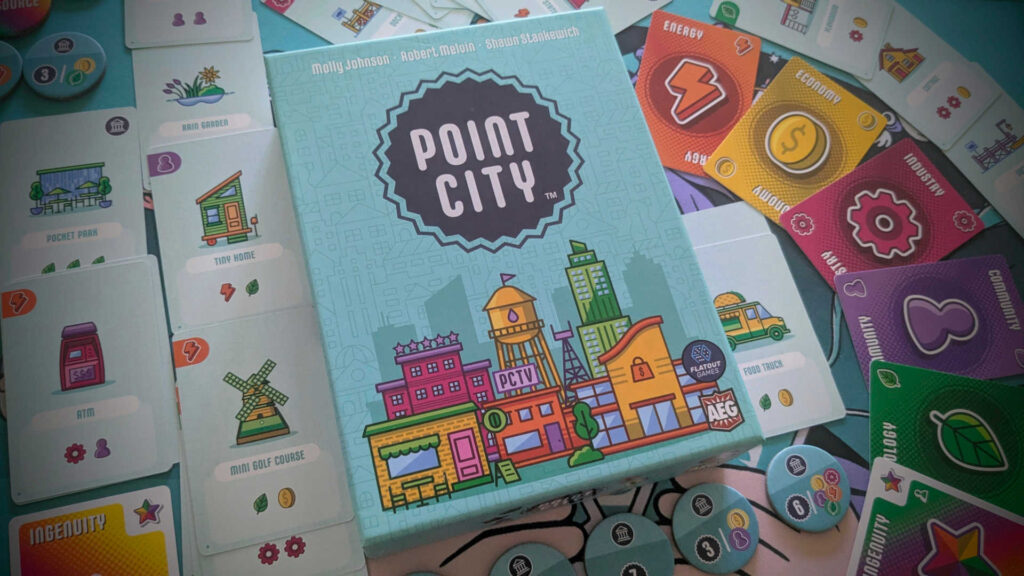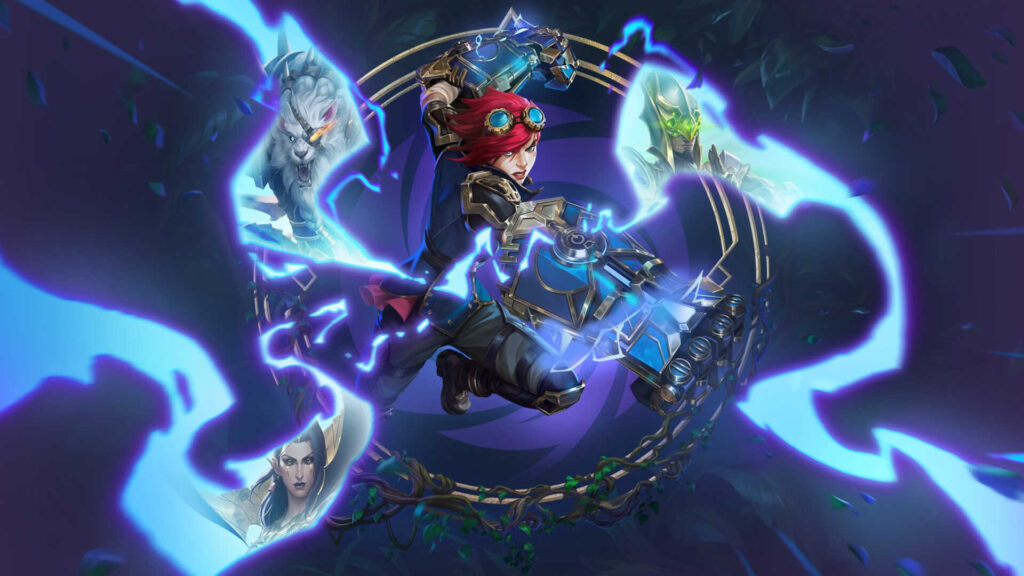Ever since the first Sim City video game became an absolute obsession of mine back in the early 90s, building cities has been one of my favorite themes, in digital as well as tabletop gaming. Point City, from Flatout Games (the makers of 2019’s acclaimed Point Salad), gives players a quick, simple game of civic construction. Is it worth playing? Let’s find out!
Table of Contents
ToggleGetting Started With Point City
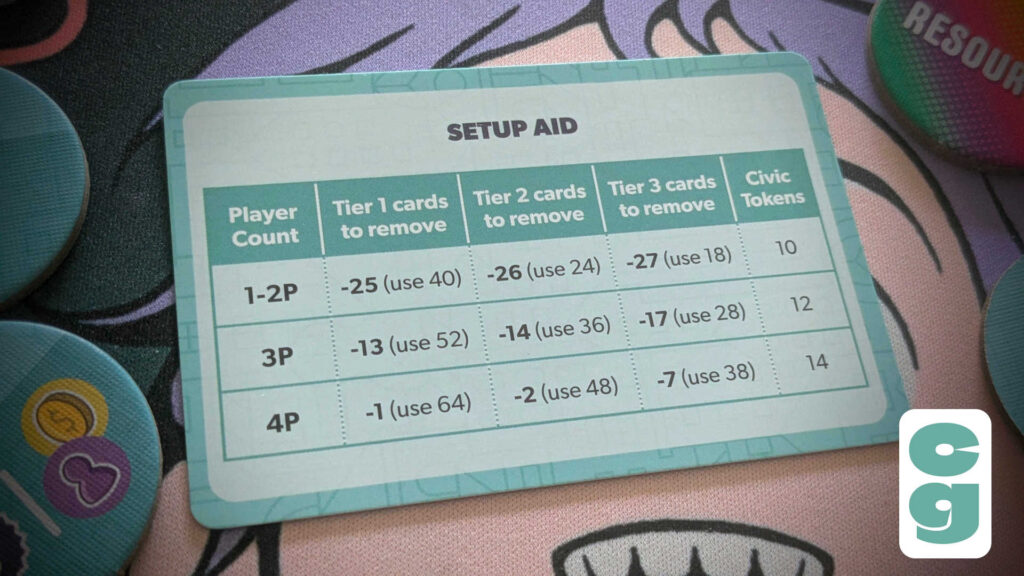
All cards in Point City are double sided, and this gives them multiple in-game uses; cards have a building side and a resource side, as well as an indicator of what “tier” they’re from (with the tiers being 1, 2 and 3). You’ll keep them on their resource side when you set up, and you’ll need to remove a certain amount of cards from each tier (depending on the number of players) in order to “build” the deck for your game.
There’s a handy reference card which gives you the breakdown, and makes setup super easy. You then put the remaining cards together, resource side up, with tier 3 cards at the bottom, tier 2 cards on top of them, and tier 1 cards at the top of the deck.
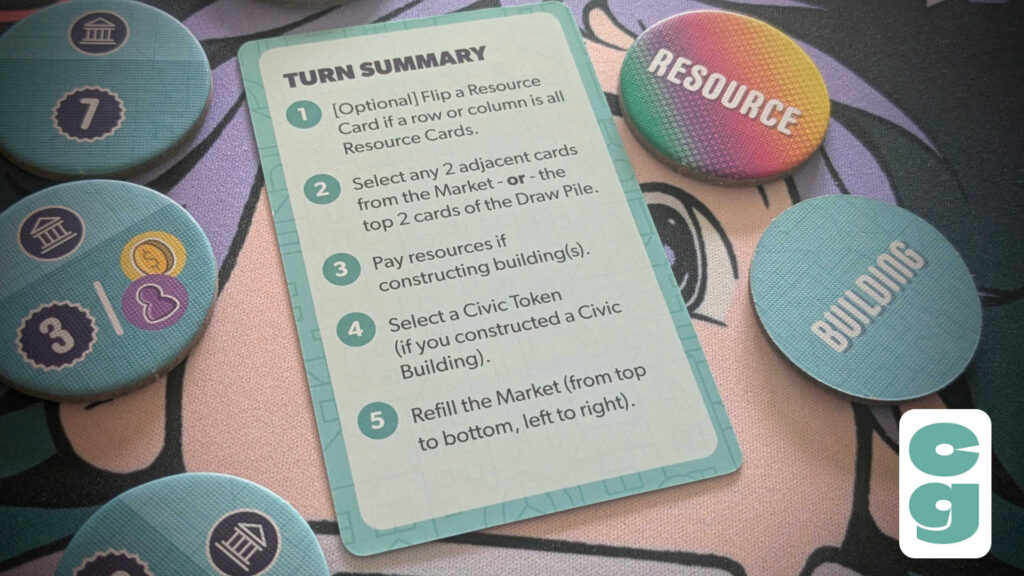
Even this reference card is double sided; the other side gives you the turn breakdown, which we’ll check out after setup! Next, you’ll remove a certain number of civic tokens from the game too, which is also shown on the setup aid card. These are placed face up in the center of the play area.
Finally, a grid of cards is created, by drawing cards one at a time from the deck, and arranging them in a 4×4 pattern, again with cards on their resource side. Players each get an Ingenuity card to start (which acts as a wild resource), and one of these has a symbol to determine the first player. Then play can begin!
How to Play Point City
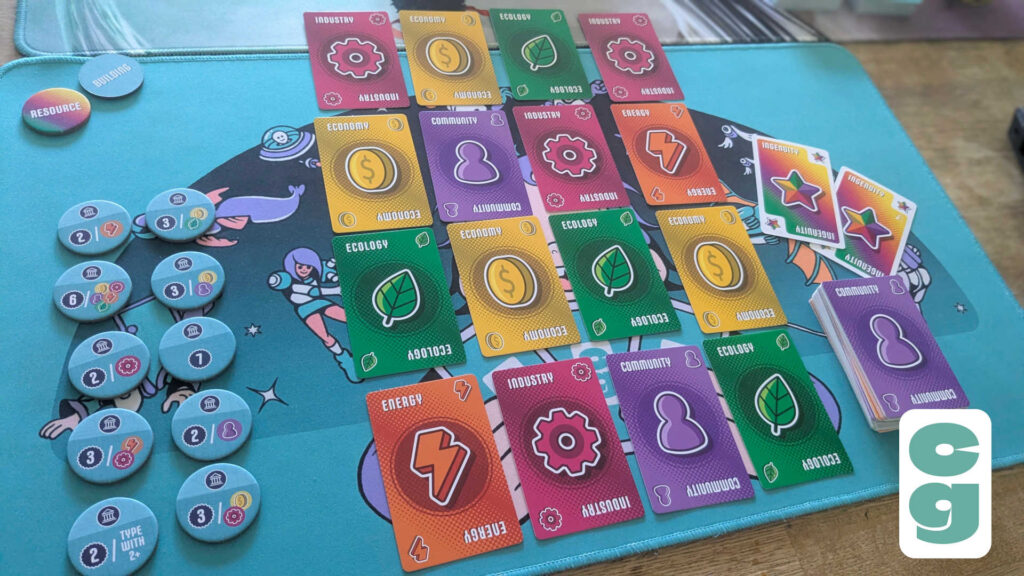
The first thing you can do on any given turn is optional; if a row or column of the card grid is solely composed of resource cards, you are able to flip one over to its building side. Then it’s just a case of choosing two cards to take; either two orthogonally (that means no diagonal) connected cards from the grid, or the top 2 cards from the draw pile.
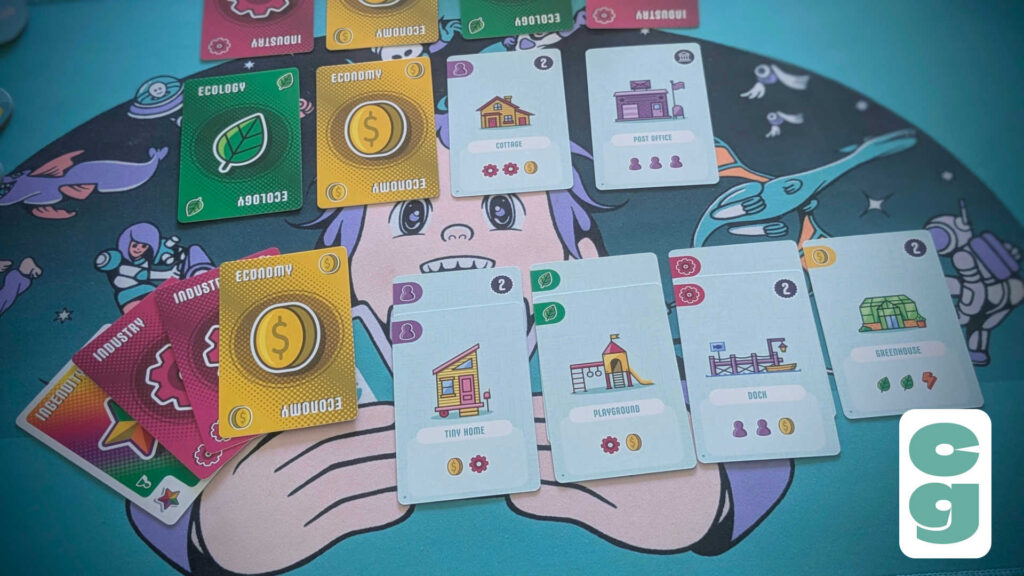
When taking a building, you need the resources to pay for it. This can come from your resource cards or any building cards you’ve already constructed, which will be face up in your play area. In the example above, you can see the cottage at the bottom of the grid has a cost of two industry and one economy, and this can be paid for from the player’s hand (on the right), or from their tableau of constructed buildings, which produce the resources in the top left of each card. You’ll note that some of the cards in the tableau provide victory points for the game’s end; three of them have 2 victory points on each!
If you construct a building with a civic symbol, you can also choose a token from those remaining in the play area. These give you points for meeting certain conditions at the end of the game; examples of civic buildings and tokens can be seen below.
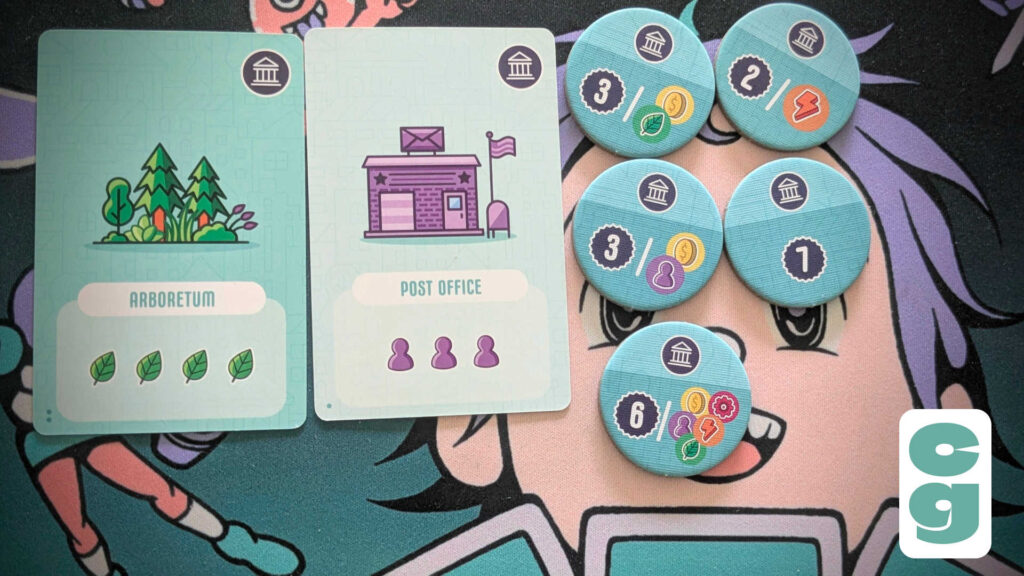
Cards are replaced in the grid one at a time, from top to bottom, left to right; if a building has been taken, it’s replaced with a resource from the top of the deck. If a resource is taken, the reverse happens; a building is placed in the empty spot after being turned over from the top of the deck.
As the game progresses, the tier 2 and tier 3 cards, with more resources and more powerful buildings, will emerge. The game ends when the grid can no longer be replenished, and this cleverly happens (thanks to that somewhat involved setup process of removing different numbers of cards depending on the number of players) as soon as each player has taken exactly 17 turns each.
Then, points are added up based on the point values on each card in a player’s city, as well as any bonuses from civic tokens that a player has collected. Then, the player with the highest score wins.
Is Point City Fun to Play?
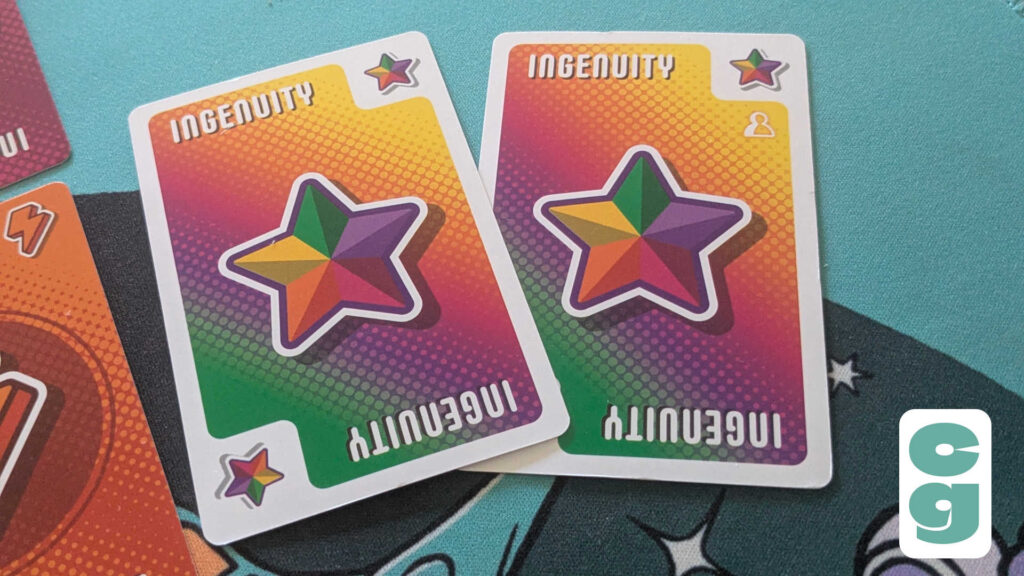
There’s a really impressive simplicity to Point City’s gameplay, despite how many options you’ll have on each turn. There’s a real strategy in ensuring that you’re taking cards in the right order, to take maximum advantage of your available resources, or in ensuring that you get your hands on a certain civic token to build up your end game points.
Despite this excellent, very well defined gameplay loop, there’s a few issues with the rules. One thing that really sticks out is that there’s no visual or text explanation for many of the civic tokens, with only a handful of them explained in the scoring example at the back of the rule book.
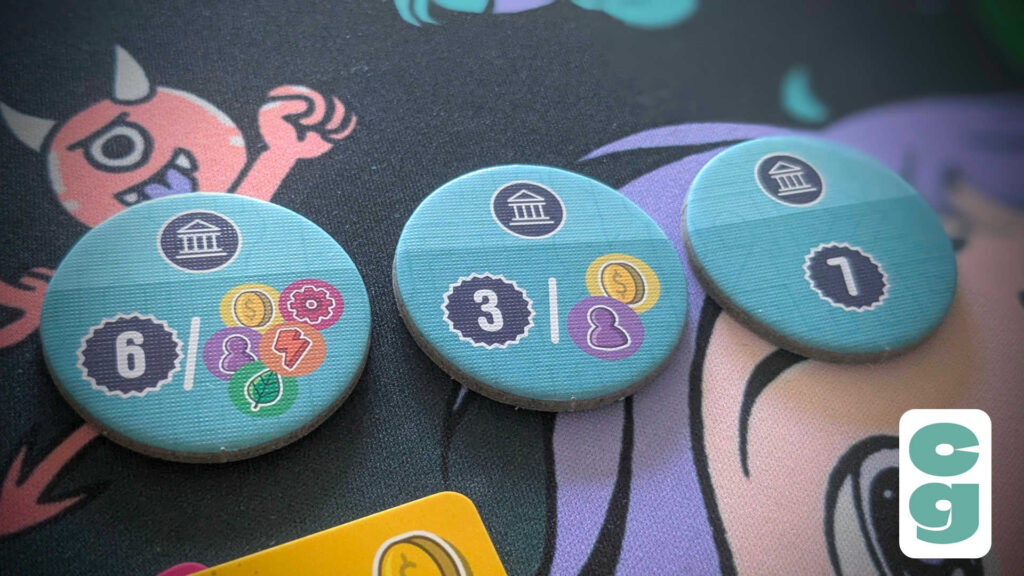
It’s a truly glaring oversight, and to make it worse, one of the game’s designers claimed (in a BoardGameGeek forum regarding confusion around the tokens) that this was simply due to not having enough space in the rules to clarify them all. Which is utterly baffling, for such a crucial element of the game.
That said, with everything laid out with clear symbols, clean artwork (cleverly using the color scheme of the resources needed for each building) and very simple rules, aside from the civic tokens, everything runs very smoothly.
With the way that you build a tableau of resources and hide your buildings aside from your most recent one in each resource category, it can feel a bit abstract and doesn’t end up giving the impression that you’re creating a city; when playing I barely absorb the building on each card, instead focusing on its cost and “output”, such as its resource generation or victory points, for the most part. Despite this, even if the theme does fall apart a little by the game’s end, its gameplay is incredibly compelling nonetheless.
There’s also support for solo players, which is always commendable. In Point City, it’s pretty well implemented and close to the “real” game, even if it doesn’t replace the experience of playing against human opponents.
The Card Gamer Verdict
With a clean, almost minimalist art style and clear iconography, Point City is a visually pleasing game with an excellent level of clarity in every aspect, aside from its lack of explanation for scoring civic tokens.
This oversight with civic tokens is a real shame, and definitely makes learning and teaching Point City more difficult than it should be, but even then it manages to recover simply by having such a compelling, clever and simple set of mechanics.
With Point City’s variable setup ensuring that players must adapt their approach for each session, there’s a good deal of replayability in its nicely compact box too. It can feel a little abstract at times, so it won’t necessarily scratch that Sim City-shaped itch, but Point City is an enjoyable and well designed game regardless.
Why not check out our feature on the classic Sim City: The Card Game? Or how about our review of Pixies, another small box, tableau building game?


